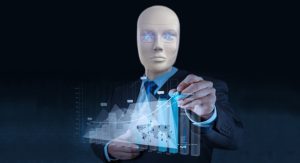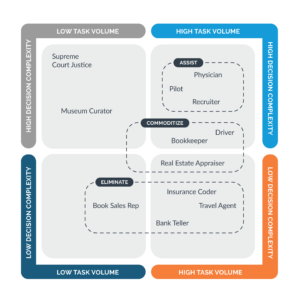 In my last post, I discussed the three ways artificial intelligence is affecting jobs: by assisting them to do their jobs better, enabling more people to do said jobs, and then, yes, eliminating jobs and displacing the people who do them.
In my last post, I discussed the three ways artificial intelligence is affecting jobs: by assisting them to do their jobs better, enabling more people to do said jobs, and then, yes, eliminating jobs and displacing the people who do them.
It can sometimes be hard to see this type of disruption coming. For example, in 1988, the Bureau of Labor Statistics (BLS) projected the number of travel agent jobs would grow by 54% by 2000. Of course, that prediction didn’t turn out to be very good – largely because it didn’t fully appreciate the influence of online booking systems, which would be made available to the public by the end of the ’90s.
What was missing for the BLS at that time was a framework to understand how technology could potentially impact jobs. Fortunately, we don’t have to operate so blindly today.
Understanding the different ways jobs can be disrupted by AI is useful, but it is even more beneficial to have a model to analyze which jobs will be impacted, how quickly and with what type of disruption. Our framework organizes job types along the parameters that matter most for successful implementation of AI: task volume and decision complexity. In other words, how often must a task be done and how complex are the decisions associated with it?
 The accompanying chart (click to enlarge) organizes a variety of jobs using this framework. It plots the jobs by task volume and decision complexity and also groups the jobs by the type of disruption risk (assist, commoditize and eliminate) that can be expected.
The accompanying chart (click to enlarge) organizes a variety of jobs using this framework. It plots the jobs by task volume and decision complexity and also groups the jobs by the type of disruption risk (assist, commoditize and eliminate) that can be expected.
Jobs with high-volume tasks are where most of the disruption risk lies. The reason is both business and technical. On the business side, there is significant incentive to automate high-volume tasks that use expensive labor. And on the technical side, high-volume tasks offer a lot of data points – a requirement for successful machine-learning AI. Predictably, the low-volume side of the chart is sparse. With limited resources, it doesn’t make much sense to solve low-volume problems, and there likely isn’t enough data available to do it anyway.
The other major input to the framework of how jobs are disrupted is decision complexity. As decision complexity increases, it becomes more and more difficult to create AI systems that can do the job. Complexity comes in many forms, including number and type of variables as well as difficulty of the decisions and sophistication of the goals.
PREMIUM CONTENT: Gross Margin and Bill Rate Trends
The framework shows that for high-volume tasks with highly complex decisions, such as those performed by physicians, pilots and recruiters, AI is used mainly to assist the job function. But for high-volume tasks with medium complexity decisions, the jobs can easily become commoditized, as with drivers and other services roles, such as real estate appraisers. And, jobs with high-volume tasks but relatively low complexity decisions, often can be eliminated, as with travel agents, bank tellers and insurance coding processors.
Note that very low complexity jobs are at risk in some cases even when the task volume is relatively low, such as with book sales reps. In contrast, the jobs least likely to be disrupted are those with very high complexity and very low volume, so the Supreme Court Justices are safe from AI disruption.
Accelerators and Inhibitors of AI
As we use the framework to think about the impact of AI, it is important to note that the results will change over time with the introduction of new technologies. This is what the BLS apparently overlooked when they predicted growth in the travel agent profession mentioned earlier. The case of the taxi driver is another example of this. As noted, when GPS technology was made available via internet-connected smartphones, the role of taxi driver got commoditized. That disruption also required the creation of platforms with marketplace dynamics that could connect service providers to customers. And it might not be long before drivers’ jobs are eliminated entirely by autonomous vehicles.
What could slow down AI disruption? Regulation and data issues. Some cities have banned ride-sharing apps for a variety of reasons. Data privacy regulations, such as HIPAA in health care, can significantly impact how AI can use data. Limitations also exist in recruiting due to data privacy rules. We must protect safety and privacy, but innovative solutions are needed to prevent AI adoption from slowing down.
AI Is Here to Stay
AI and the automation of human decision making is essential for increasing efficiency and productivity,and creating higher standards of living overall. Yes, this will cause job disruption and drive retraining needs, but that doesn’t change the fact that AI is not going away. The key is to understand where and how the disruption is occurring so people can adapt and learn the skills needed to thrive in the new environment created by technological innovation. This is how we can all benefit from AI’s potential.








